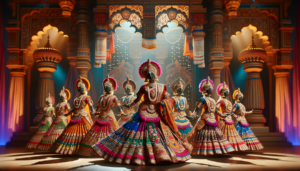The History of Jazz Dance
Jazz dance is an energetic and expressive dance form that developed alongside jazz music, originating from Black American culture in the early 20th century. It has since evolved into diverse styles and influenced various forms of dance around the world.
Origins and Early Development
The roots of jazz dance can be traced back to the rhythmic dances brought to America by African slaves. Over time, these dances mixed with European influences and evolved into new forms. Minstrel shows and vaudeville acts in the 19th century featured early jazz dances like the cakewalk, which contributed to the development of the genre.
| Era | Key Development |
|---|---|
| 19th century | Early jazz dances emerge in minstrel shows and vaudeville |
| Early 20th century | Jazz music gains popularity, influencing dance |
By the early 20th century, jazz music was gaining widespread popularity. Dances like the Charleston, Black Bottom and Lindy Hop developed, characterized by improvisation, rhythm, and high energy.
Jazz Dance in the Swing Era
The 1930s and 40s, known as the Swing Era, saw jazz dance surge in popularity. Big bands led by Duke Ellington, Benny Goodman and others drew huge crowds to dance halls. The jitterbug, a lively partner dance, took the nation by storm during this time.
A few key developments of the Swing Era include:
- Jitterbug becomes a dance craze
- Big band jazz dominates popular music
- Partner dancing and improvisation are emphasized
The energy and spirit of the Swing Era made a lasting impact on jazz dance. Many classic jazz steps and styling elements popular today originated in this period.
Modern Evolution of Jazz Dance
In the decades following the Swing Era, jazz dance continued to evolve, absorbing influences from other genres. Choreographers like Jack Cole and Bob Fosse developed new jazz techniques and popularized jazz on stage and screen in the 1950s-70s.
Modern jazz dance incorporates a wide variety of styles. It can be seen on Broadway, in film and television, and in competitive dance. While it maintains its roots, it also fuses with contemporary dance forms and music.
The global influence of jazz dance is undeniable. From its African-American origins, it has grown into a beloved dance form worldwide, both in its pure form and as a major influence on other genres. Jazz dance continues to evolve in new and exciting directions.
Different Styles of Jazz Dance
Over the course of its history, jazz dance has developed into a number of distinct styles. While all rooted in African-American cultural dance and jazz music, each style has its own unique characteristics and techniques.
Classic Jazz Dance
Classic jazz is the dance style most people think of when they hear “jazz dance”. It developed from early Broadway shows, films, and dance performances from the 1920s-40s. Key features include:
- Upright posture
- Precise, linear movements
- Highly energetic
- Isolations of body parts
- 4/4 time signature (like jazz music)
Famous classic jazz choreographers include Jack Cole, Eugene Louis Faccuito (Luigi), and Gus Giordano. Classic jazz is still widely taught and performed around the world as a foundation for jazz technique.
Theater Jazz
Theater jazz emerged from Broadway musicals, combining jazz and ballet techniques for a highly expressive, theatrical style. Bob Fosse was a major innovator of theater jazz, with his signature turned-in knees and toes, hip isolations, and snappy hand movements.
Some other key features include:
- Long lines and extensions
- Storytelling and emoting with the body
- Detailed hand and arm gestures
- Incorporation of props like hats and canes
Theater jazz is defined by its focus on performance and characterization. It is the style most often seen in Broadway choreography to this day.
Contemporary Jazz
Contemporary jazz is an ever-evolving style that combines traditional jazz with modern dance elements. It emerged in the late 20th century and incorporates influences from lyrical, ballet, and modern dance techniques.
Characteristics of contemporary jazz include:
- Fluidity and sustained movements
- Focus on musicality and expression
- Infusion of other styles like hip hop and world dance
- Emphasis on floorwork and inversions
Contemporary jazz continues to evolve with the influence of popular music and dance trends. It has become a major style in the competitive dance world and commercial dance industry.
While these three major styles provide a framework for understanding jazz dance, there are many other subcategories. Teachers and choreographers constantly innovate jazz dance, making it an exciting and ever-changing art form.
Essential Moves in Jazz Dance
Jazz dance is known for its vibrant and energetic movements that emphasize rhythm and individual expression. Over time, a canon of foundational jazz steps and moves has formed the basis for choreography and improvisation.
Basic Jazz Dance Steps
Most jazz dancers start by learning a core set of steps that are combined and built upon in choreography. Some of the most important basic jazz steps include:
| Step | Description |
|---|---|
| Ball change | A quick transfer of weight from one foot to the other |
| Chassé | A “chase” with one foot “chasing” the other in a series of steps |
| Jazz walk | A stylized walk forward, often with hip articulation |
| Pas de bourrée | A quick three-step sequence: back, side, front |
| Pirouette | A turning step on one leg, often with knee bent |
These building blocks provide a foundation for jazz dancers to develop their technique and for choreographers to create dynamic combinations and routines.
Intermediate and Advanced Moves
As jazz dancers progress, they incorporate more complex and challenging movements into their vocabulary. Some examples of intermediate to advanced jazz moves include:
- Fouetté turns: A fast turning sequence that opens to the side with each revolution
- Tilt: An off-balance lean with one leg extended, originally created by choreographer Frank Hatchett
- Pencil turn: A fast 360-degree turn on one leg with the ankles and legs squeezed tightly together
- Barrel roll: A floorwork move that rolls the body to the side with legs extending in the air
Jumps and leaps are also important advanced elements in jazz dance. From the straddle jump to the turning c-jump, explosive leaps feature heavily in jazz choreography and push dancers’ strength and coordination.
Iconic Jazz Dance Routines
Certain jazz dance routines have gained iconic status over the years. Many of these routines were choreographed for film or stage and showcase the quintessential elements of jazz dance. Some famous examples include:
- “Cool” from West Side Story, choreographed by Jerome Robbins
- “Rich Man’s Frug” from Sweet Charity, choreographed by Bob Fosse
- “Steam Heat” from The Pajama Game, choreographed by Bob Fosse
- “Chorus Line” opening number, choreographed by Michael Bennett
Studying and deconstructing these legendary jazz routines provides endless inspiration for dancers and choreographers alike. They exemplify how jazz vocabulary is used to craft dynamic, powerful performances that capture the audience.
The codified steps and celebrated routines of jazz dance may seem rigid, but they are simply tools for creative expression. The best jazz dancers use their mastery of technique to transcend the form and embody the free spirit of jazz improvisation.
Influence of Jazz Dance on Other Dance Forms
Jazz dance has had a profound impact on the world of dance, crossing boundaries and influencing countless other styles. The freedom, musicality, and individual expression of jazz can be seen in everything from ballet to hip hop.
Fusion with Ballet
In the mid-20th century, choreographers began to experiment with fusing jazz and ballet, drawn to the contrast between the upright precision of ballet and the grounded, sensual movements of jazz. George Balanchine was a major innovator in this realm, choreographing ballet to jazz scores.
This fusion paved the way for contemporary ballet, a style that incorporates jazz-inspired elements like:
- Syncopated rhythms
- Jazz port de bras (arm movements)
- Parallel positions of the feet
- Hip and shoulder isolations
Choreographers like Twyla Tharp have continued to blend jazz and ballet in groundbreaking ways, making the fusion a mainstay of contemporary dance.
Impact on Social Dances
Jazz rhythm and improvisation have inspired many social dance crazes over the last century. During the jazz age of the 1920s, dances like the Charleston and Black Bottom were all the rage. They featured exuberant, syncopated movements set to hot jazz music.
Later, during the Swing Era, partner dances like the Jitterbug and Lindy Hop evolved out of the jazz tradition. These dances were fast, acrobatic and highly improvisational, danced to the big band swing music of the day.
Even as popular music has evolved in the decades since, the imprint of jazz dance can still be seen in social dances. Disco, funk, and hip hop dance styles all share the emphasis on individual expression, complex rhythms and isolations that define the jazz aesthetic.
Jazz Dance in Popular Culture
Jazz dance has long captured the public imagination, playing a starring role in films, television, music videos and live performances. Hollywood movies of the 1930s-50s like A Day at the Races (1937) and Singin’ in the Rain (1952) featured lavish jazz dance numbers that delighted audiences.
Later, films like All That Jazz (1979), Flashdance (1983), and Chicago (2002) placed jazz dance center stage, exposing new generations to the art form. On television, shows like So You Think You Can Dance and Dancing with the Stars frequently showcase jazz routines.
Jazz dance has also left an indelible mark on the music industry. Legendary performers like Michael Jackson, Janet Jackson, Paula Abdul, and Beyoncé are known for their jazz-inspired choreography. Music videos have provided an exciting medium for jazz choreographers to explore visual storytelling through dance.
As a pillar of American cultural dance, jazz has shaped our collective understanding of dance as an art form. Its influence stretches from the avant-garde to the mainstream, constantly cross-pollinating with other styles.
Notable Jazz Dance Performances and Choreographers
Throughout its history, jazz dance has been pushed forward by visionary performers and choreographers. From the early innovators to today’s trailblazers, these artists have expanded the boundaries of the genre.
Iconic Performances
Some jazz dance performances are so groundbreaking that they forever change the landscape of the art form. For example, Jack Cole’s sizzling, Afro-Caribbean-infused “Beale Street Blues” in the 1948 film The I Don’t Care Girl introduced a new, sensual jazz vocabulary.
Bob Fosse’s 1969 film Sweet Charity is another watershed moment. Numbers like “Big Spender” and “Rich Man’s Frug” epitomized Fosse’s iconic style: bowler hats, jazz hands, sideways shuffling, and rolled shoulders. This cemented his legacy as one of the most influential jazz choreographers of all time.
In the music video realm, Michael Jackson’s 1983 “Thriller” was a game-changer. The 14-minute epic, featuring choreography by Michael Peters and Michael Jackson, is considered one of the greatest music videos of all time.
Renowned Choreographers
Jazz dance would not be where it is today without the tireless innovation of key choreographers. In addition to giants like Jack Cole and Bob Fosse, the jazz dance canon has been shaped by the likes of:
- Jerome Robbins: Choreographed the original Broadway productions of West Side Story, Peter Pan, and Fiddler on the Roof. Infused jazz with ballet.
- Gus Giordano: A major proponent of classic jazz dance, founded Giordano Dance Chicago. Created the Giordano Technique.
- Frank Hatchett: Pioneered an explosive, syncopated style he termed VOP (Value of Precision). Established the acclaimed Broadway Dance Center.
- Matt Mattox: Influenced by Jack Cole, invented his own “freestyle” technique. Worked extensively on stage and screen.
These are just a few of the luminaries who have advanced jazz dance through their unique choreographic voices. Today, a new generation of jazz choreographers carries the torch, finding innovative ways to honor the roots of jazz while pushing it forward.
Jazz Dance on YouTube
The digital age has made it easier than ever to see great jazz dance performances from around the world. YouTube in particular has become a hub for the jazz dance community to share work, with countless channels dedicated to classes, choreography, and performances.
One recent viral video is titled “Kill The Lights – Jazz Competition Dance” by Shooting Stars Dance Studios. The video features choreography by Hillary Temple and Nicole Deanda and has garnered over 2 million views since it was posted in 2019. The energetic, precise routine showcases the excitement of competition-level jazz dance today.
Another YouTube standout is choreographer Emma Scherer’s “Theater Jazz Choreography demo”. The video has over 1.6 million views and features Scherer’s original choreography blending classic theater jazz with fresh contemporary elements. Her dynamic staging and storytelling reflect the enduring influence of broadway jazz.
With the wealth of jazz dance available at our fingertips, it has never been easier to tap into this vibrant art form. From classic clips of bygone legends to cutting-edge choreography sweeping the competition circuit, jazz dance on YouTube offers endless inspiration and education. The comment sections are full of dancers and enthusiasts celebrating the past, present and future of jazz dance.
As long as there are artists driven to express themselves through rhythm and movement to jazz music, the legacy of jazz dance will live on. It is an art form that is at once timeless and ever-evolving, forever a part of the cultural fabric.
#ED#






